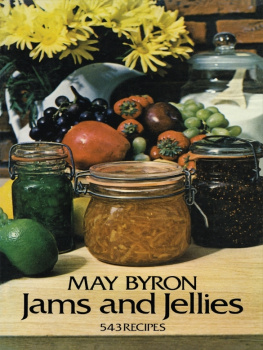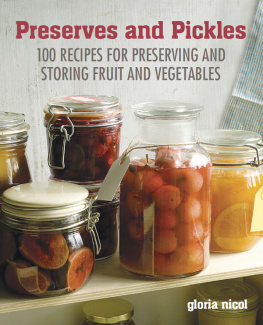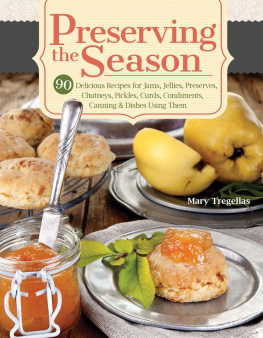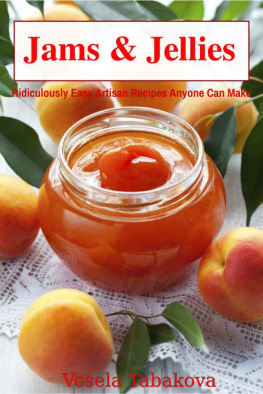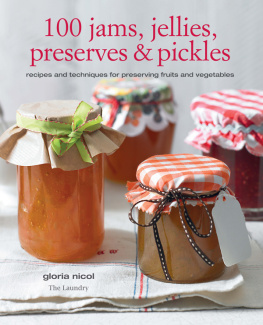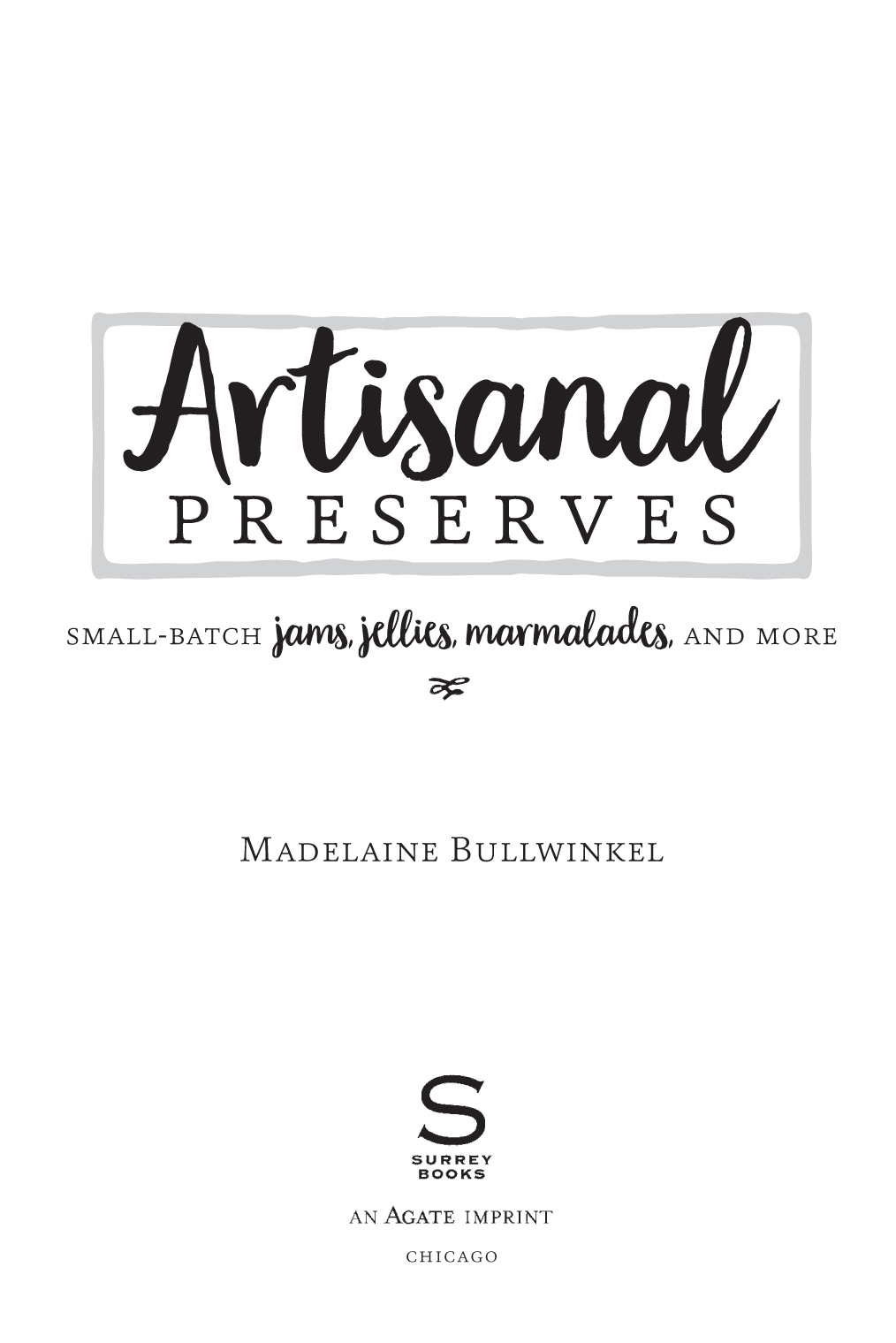INTRODUCTION
Rarely does a cooking teacher have the opportunity to share a long-time passion with a new generation of eager cooks and seasoned preservers alike. I dont think you will be disappointed. The recipes in Artisanal Preserves remain true to the traditional methods that first inspired me to make jams and jellies more than thirty years ago. At the same time, they keep pace with both cooking trends and technical preserving advances in the 21st century. Each recipe has evolved slowly and naturally over years of testing, sampling, and enjoying at Chez Madelaine, my home-based cooking school.
Artisanal Preserves is really two books in one. If you are new to fruit preserving, the second chapter will read like an owners manual. A list of instructions also accompanies each preserving subject in the chapters that follow. But, trust me, once you have the basic techniques mastered, the process of cooking preserves will become both predictable and fun. Additional rewards await you in the baking and dessert sectionsthose recipes provide an opportunity to amplify delicious homemade treats with your personally created preserves. Dont even try to resist!
Artisanal Preserves captures, in its technical efficiency, the spirit of new approaches to fruit preserving. For instance, careful experimentation over the years has led me to develop recipes for small fruit quantitiesoften appropriate for limited family needsthat preserve full flavor with a minimum of cooking and adhere to natural pectin levels, which means less added sugar. We now vacuum seal all preserves, in keeping with standards of the preserving industry, which has discarded melted paraffin as both unreliable and flammable. All our breads are now checked for doneness with a modern, instant-read thermometer, so we can say goodbye to the guesswork of thumping on hot loaves.
Look for some (to me) daring technical twists, such as the use of powdered commercial pectin; it helps make Quick Preserves and comes to the rescue when preserves refuse to jell. You will learn how to add just the right amount of pectin powder to keep sugar levels the same as they would be if you used only naturally occurring fruit pectin. Preserve connoisseurs will still prefer the texture and mouth-feel of natural pectin in jelly, preserves, and marmalades, but, like me, I think you will be grateful to have an alternative when time is limited.
What hasnt changed in the many years I have been making fruit preserves is the knowledge that each labeled jar is truly a present from the heartfrom me, from my kitchen. Theres no better gift nor way to say thank you to friends and associates. I make sure to pack several quarter-pint jars in my carry-on bag each time I lead a tour group to France, knowing that old friends will be looking forward to receiving these unique personal gifts as an expression of our common love of life at the table.
Now its time for you to join with me in the pleasure and satisfaction of creating an abundance of elegant and delicious fruit preserves right in your own home kitchen. After you have tried your hand at fruit preserving, let me know how you have fared. Please send news of your successes, questions, and recipe creations to me at: chezmpreserves.com .
1A SHORT HISTORY OF PRESERVING
T HE FIRST PRESERVES
From the earliest times, out of sheer necessity, our ancestors preserved abundant harvests for later consumption. These pre-scientific forebears often saw their precious food supply succumb to decay from mold and bacteria, so they learned to freeze fruits, vegetables, meats, and fish in cold regions and air-dry them in hot, arid climates.
The Romans tried to preserve fresh figs, pears, and plums in honey, not realizing that raw produce can still decay from within in the absence of air. Evidence of the first cooked fruit preserved in sugar comes from the early years of the Italian Renaissance. The fruits are described in Boccaccios fourteenth-century writing as luxurious fare for the aristocracy living a romantic lifestyle. At that time sugar was imported from the Near East through Venice; it remained rare and quite expensive through the eighteenth century.
T HE SEARCH FOR CHEAP SUGAR
By the middle of the sixteenth century, translations of Italian cookbooks with recipes for preserves began to appear in France. The first instance of a marmalet in an English cookbook dates from the early 1500s. Its source was a Portuguese recipe for preserved marmelo quince. Sweet preserves graced the royal tables of Europe with increasing regularity as their popularity spread northward. When the New World was cultivated, sugar became a staple crop, and preserves became part of the European legacy.
Many islands in the Caribbean grew generous sugar crops using slave labor. There were also good-sized sugar plantations in Louisiana, Alabama, Florida, Georgia, and Mississippi before the Civil War. But the sugar content of American crops was lower than that grown in the West Indies, so the United States imported cheap molasses from the islands to meet its sugar needs. Only in the mid-nineteenth century was an inexpensive method for processing cane sugar perfected. On the heels of this discovery came the burgeoning production of sugar from beets. Now many more households could afford to experience the pleasures of preserves.
T HE VACUUM SEAL: A TIMELESS INVENTION
In 1810, in France, Nicholas Appert invented a method for canning in glass jars. But it took another century and the ingenuity of three Americans to bring a safe preserving vacuum-sealed jar to the home cook in America. John Mason first patented a glass jar with threaded top and airtight metal cap. The Ball brothers picked up Masons designs when his patents expired and continued to make Masons jars. In 1915 John Kerr bought the rights to a German heat-sealing gasket on a lacquered metal lid that would vent air when heated and then seal quickly when cooled. Today we buy Balls version of the Mason jar with a Kerr screw cap lid.



